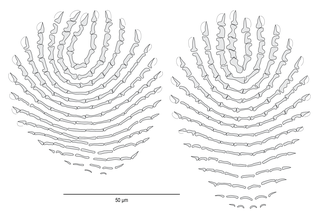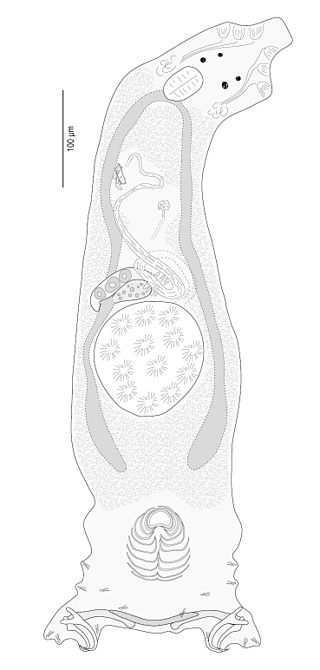Related Research Articles

Pseudorhabdosynochus is a genus of monopisthocotylean monogeneans, included in the family Diplectanidae. The type-species of the genus is Pseudorhabdosynochus epinepheli .

The Diplectanidae are a family of monopisthocotylean monogeneans. They are all parasitic on the gills of fish. Diplectanids are small animals, generally around 1 mm in length. As parasites, they can be extremely numerous, up to several thousand on an individual fish.

Squamodiscs are epidermal structures, which are typical of and found only in certain monogeneans of the family Diplectanidae. There are, typically, two squamodiscs, one ventral and one dorsal, located on the haptor of the monogenean. Squamodiscs are usually made up of scales embedded in the epidermis, which appear from the outside as rodlets arranged in rows.

Pseudorhabdosynochus epinepheli is a diplectanid monogenean parasitic on the gills of species of groupers. It is the type species of the genus Pseudorhabdosynochus Yamaguti, 1958.
Alexandr Vladimirovich Gussev, sometimes spelled Gusev in the literature, was a Russian helminthologist specialist of monogeneans.
Calydiscoides is a genus of monopisthocotylean monogeneans, included in the family Diplectanidae.

Pseudorhabdosynochus capurroi is a diplectanid monogenean parasitic on the gills of the Black grouper, Mycteroperca bonaci. It was described by Vidal-Martínez and Mendoza-Franco in 1998 and redescribed successively by Yang, Gibson and Zeng in 2005 and by Kritsky, Bakenhaster and Adams in 2015.

Pseudorhabdosynochus beverleyburtonae is a diplectanid monogenean parasitic on the gills of the dusky grouper, Epinephelus marginatus. It has been described by Guy Oliver in 1984 as Cycloplectanum beverleyburtonae, redescribed by Oliver in 1987, transferred to the genus Pseudorhabdosynochus by Kritsky & Beverley-Burton in 1986 as Pseudorhabdosynochus beverleyburtonae, redescribed by Kritsky, Bakenhaster and Adams in 2015, and redescribed in 2016 by Chaabane, Neifar, Gey & Justine.

Lamellodiscus is a genus of monopisthocotylean monogeneans in the family Diplectanidae; all species of Lamellodiscus are small worms, parasitic on the gills of teleost fish.
Pseudorhabdosynochus amplidiscatus is a diplectanid monogenean parasitic on the gills of groupers. It was described as Diplectanum amplidiscatum by Bravo-Hollis in 1954 and transferred to the genus Pseudorhabdosynochus by Kritsky and Beverley-Burton in 1986.

Ancyrocephalidae is a family of monogenean flatworms. The family is considered as a "temporary name" in WorMS but includes a large number of genera and species.
Acleotrema is a genus of monopisthocotylean monogeneans in the family Diplectanidae. All its species are parasites on fish. The type-species is Acleotrema girellaeJohnston & Tiegs, 1922.
Delane C. Kritsky is an American parasitologist who specialised on the Monogenea, a class of parasitic flatworms which are important ectoparasites of fishes. His research was mainly in the fields of taxonomy, faunistics, and phylogeny of the Monogenea.

Microcotyle archosargi is a species of monogenean, parasitic on the gills of a marine fish. It belongs to the family Microcotylidae. It was first described by MacCallum in 1913 based on ten specimens. Hargis (1956) pointed out that the description and figures given by MacCallum were poor in details.
Pseudorhabdosynochus hargisi is species of a diplectanid monogenean parasitic on the gills of the White grouper Epinephelus aeneus. It was described in 1984 as Diplectanum hargisi and transferred to the genus Pseudorhabdosynochus by Santos, Buchmann & Gibson in 2000. Its systematic position has been clarified by Kritsky, Bakenhaster & Adams in 2015, who differentiated it from Pseudorhabdosynochus americanus.
Pseudorhabdosynochus melanesiensis is a diplectanid monogenean parasitic on the gills of the grouper, Epinephelus merra. It was described in 1958 as Diplectanum melanesiensis then transferred to the genus Pseudorhabdosynochus by Kritsky & Beverley-Burton in 1986.
Lobotrema is a genus of monopisthocotylean monogeneans, belonging to the family Diplectanidae. All its species are parasites on fish. The type-species is Lobotrema madrasiTripathi, 1959.
Murraytrematoides is a genus of monopisthocotylean monogeneans in the family Diplectanidae.

Neodiplectanum is a genus of monopisthocotylean monogeneans, belonging to the family Diplectanidae. According to Mizelle & Blatz (1941), the genus Neodiplectanum "differs from DiplectanumDiesing, 1858, its closest relative, by the presence of two, instead of three, cuticular bars on the haptor". Oliver (1987) thought that the two genera were synonyms, but Neodiplectanum was resurrected later.
Protolamellodiscus is a genus of monopisthocotylean monogeneans in the family Diplectanidae. All species of Protolamellodiscus are parasites of marine perciform fishes of the families Lethrinidae, Nemipteridae, Serranidae and Sparidae.
References
- 1 2 3 Mizelle, J. D., & Blatz, V. (1941). Studies on monogenetic trematodes. VI. Two new dactylogyrid genera from Florida fishes. The American Midland Naturalist, 26(1), 105-109. PDF in JSTOR
- 1 2 WoRMS (2018). Rhabdosynochus Mizelle & Blatz, 1941. Accessed at: http://www.marinespecies.org/aphia.php?p=taxdetails&id=717453 on 2018-12-23
- ↑ Hargis, W.J. Jr. (1955) Monogenetic Trematodes of Gulf of Mexico Fishes. Part III. The Superfamily Gyrodactyloidea (continued). Quarterly journal of the Florida Academy of Sciences, 18, 33–47.
- ↑ Bychowsky, B. E. (1957) Monogenetic Trematodes. Their systematic and phylogeny. Akad. Nauka. USSR. English translation by the American Institute of Biological Science, Washington. 509 pp. doi : 10.5962/bhl.title.7475

- ↑ Yamaguti, S. (1963) Systema Helminthum IV. Monogenea and Aspidocotylea. London-New York, Interscience Publishers. 699 pp.
- ↑ Oliver, Guy (2015). Les Diplectanidae Bychowsky, 1957 (Monogenea, Monopisthocotylea, Dactylogyridea). Systématique. Biologie. Ontogénie. Écologie. Essai de phylogenèse (thesis). Figshare. doi: 10.6084/M9.FIGSHARE.1295274 .
- 1 2 3 4 Mendoza-Franco, Edgar F.; Violante-González, Juan; Vidal-Martínez, Víctor M. (2008). "New species of Rhabdosynochus Mizelle and Blatz 1941 (Monogenoidea: Diplectanidae) from the gills of centropomid fishes (Teleostei) off the Pacific Coast of Mexico". Journal of Parasitology. 94 (1): 28–35. doi:10.1645/GE-1241.1. ISSN 0022-3395. PMID 18372618. S2CID 42061690.
- 1 2 Kritsky, D.C.; Boeger, W.A.; Robaldo, R.B. (2001). Neotropical Monogenoidea. 38. Revision of Rhabdosynochus Mizelle and Blatz, 1941 (Polyonchoinea: Dactylogyridea: Diplectanidae), with descriptions of two new species from Brazil. Comparative Parasitology. 68: 66-75.
- ↑ Mendoza-Franco, Edgar F.; Violante-González, Juan; Vidal-Martínez, Víctor M. (2006). "A new diplectanid (Monogenea) genus and species from the gills of the black snook, Centropomus nigrescens (Perciformes: Centropomidae) of the Pacific coast of Mexico". Journal of Parasitology. 92 (3): 481–485. doi:10.1645/GE-3538.1. ISSN 0022-3395. PMID 16883989. S2CID 2466041.
- ↑ Montero-Rodríguez, Marilú; Mendoza-Franco, Edgar F.; Téllez, Norma A. López (2020-11-08). "New species of Rhabdosynochus Mizelle and Blatz 1941 (Monogenoidea: Diplectanidae) from the gills of the cultured Centropomus viridis (Perciformes) in the Mexican Eastern Tropical Pacific". Acta Parasitologica. 66 (2): 487–492. doi: 10.1007/s11686-020-00303-1 . ISSN 1230-2821. PMID 33161480.
- 1 2 Caña-Bozada, Víctor; Morales-Serna, F. Neptalí; Fajer-Ávila, Emma J.; Llera-Herrera, Raúl (2022). "De novo transcriptome assembly and identification of G-Protein-Coupled-Receptors (GPCRs) in two species of monogenean parasites of fish". Parasite. 29: 51. doi: 10.1051/parasite/2022052 . ISSN 1776-1042. PMC 9645230 . PMID 36350193.
